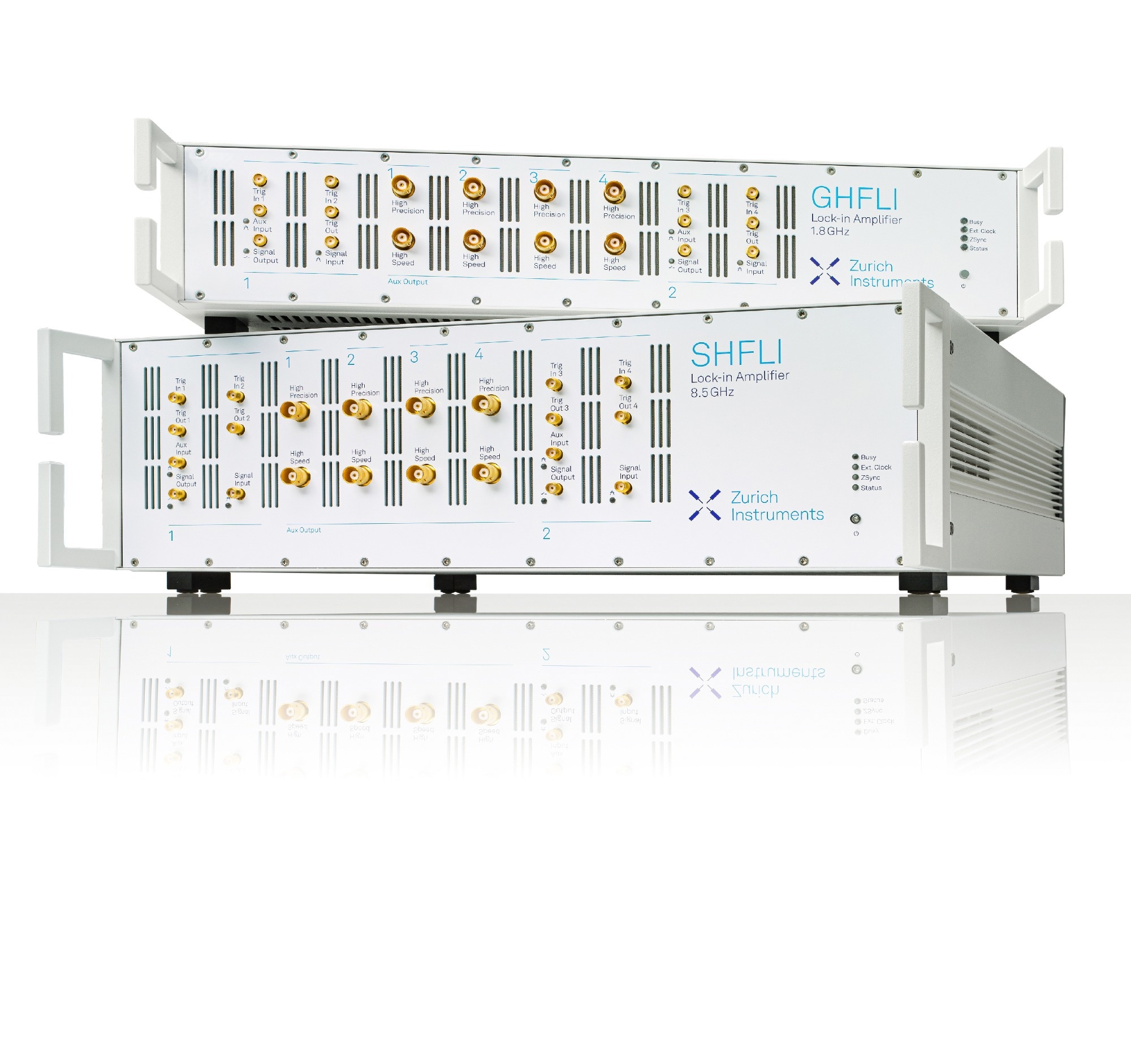Zurich Instruments' new GHFLI and SHFLI bring the advantages of lock-in detection – noise rejection, phase sensitivity, frequency tracking and more – to the GHz range. With measurement frequencies up to 1.8 and 8.5 GHz, respectively, these two trailblazing instruments target applications such as RF MEMS and NEMS characterization and control, spin qubits, ultrafast laser spectroscopy, spintronics, electronic devices failure analysis. Each instrument offers 2 independent lock-in channels and combines them with a full microwave measurement suite that includes an Oscilloscope, Spectrum Analyzer, Parametric Sweeper and more, reducing complexity for scientists and engineers.
The instruments

Image credit: Zurich Instruments
The GHFLI and SHFLI can handle a wide variety of experimental conditions thanks to their two independent channels, each of which can measure multiple signals in parallel and generate multi-tone waveforms. The intuitive user interface allows running all the measurement tools simultaneously, providing an overview of the signals at a glance. Their demodulator filters provide the freedom to find the best tradeoff between noise rejection and measurement speed in every situation, with a time constant tunable between 14 ns and 21 s.
The GHFLI and SHFLI are equipped with 8 demodulators, so they can measure up to 8 harmonics at the same time – or even 8 arbitrary frequencies with the multi-frequency option – and provide amplitude and phase for each; any application that needs measurements at different frequencies will see a great reduction in acquisition time with the GHFLI and SHFLI by measuring at up to 8 frequencies simultaneously. In comparison, stand-alone Spectrum Analyzers, the usual choice for measuring signals dynamically at these frequencies, measure a single frequency component and only provide its amplitude
The high-data-rate digital interfaces enable simple data acquisition while, at the same time, the 8 auxiliary outputs can convert the results into analog signals for integration with other instrumentation or to provide feedback to the system. Both instruments can operate down to DC, the GHFLI measuring up to 1.8 GHz and the SHFLI up to 8.5 GHz.
Software
The GHFLI and SHFLI include the LabOne® control software that makes setting them up easy and convenient: the graphical user interface offers an intuitive approach to instrument control and data visualization and, thanks to its tab design, all tools in the measurement suite can run in parallel and be a maximum of 1 click away. Additionally, all the functionality and data acquisition can be accessed through the major programming languages for ease of integration: LabVIEWTM, MATLAB®, C, .NET and Python are supported.
Researchers working on electronic devices characterization, MEMS, photonics and scanning probe microscopy, in particular, will benefit from the built-in Sweeper that greatly simplifies the automation of tasks such as the measurement of transfer functions, spectral noise densities and many other parametric scans.
Thanks to the benefits of lock-in detection, and the versatility of their measurement suite, the GHFLI and SHFLI are ideal choices to measure periodic signals quickly and reliably, benefiting a broad range of applications from DC to 8.5 GHz.
--------------
To learn more about the new Zurich Instruments microwave lock-in amplifiers visit www.zhinst.com and the GHFLI and SHFLI Lock-in Amplifiers page where you can find an overview video and links to more resources.
Register here to join us at the GHFLI and SHFLI online launch event.
To arrange a demo or discuss your application, write to [email protected].
About Zurich Instruments
Zurich Instruments makes cutting-edge instrumentation for scientists and technologists in advanced laboratories who are passionate about phenomena that are often notoriously difficult to measure. The company’s core offering includes lock-in amplifiers, impedance analyzers, arbitrary waveform generators, and the first commercially available quantum computing control system.
Zurich Instruments brings innovation to scientific instrumentation and quantum control systems in the medium-frequency (MF), ultra-high-frequency (UHF) and now also super-high-frequency (SHF) ranges by combining frequency- and time-domain tools within each of its products. This approach reduces the complexity of laboratory setups and unlocks new measurement strategies.
Press contact
Zurich Instruments AG
Kivanç Esat, Application Scientist
Technoparkstrasse 1
8005 Zürich
Switzerland